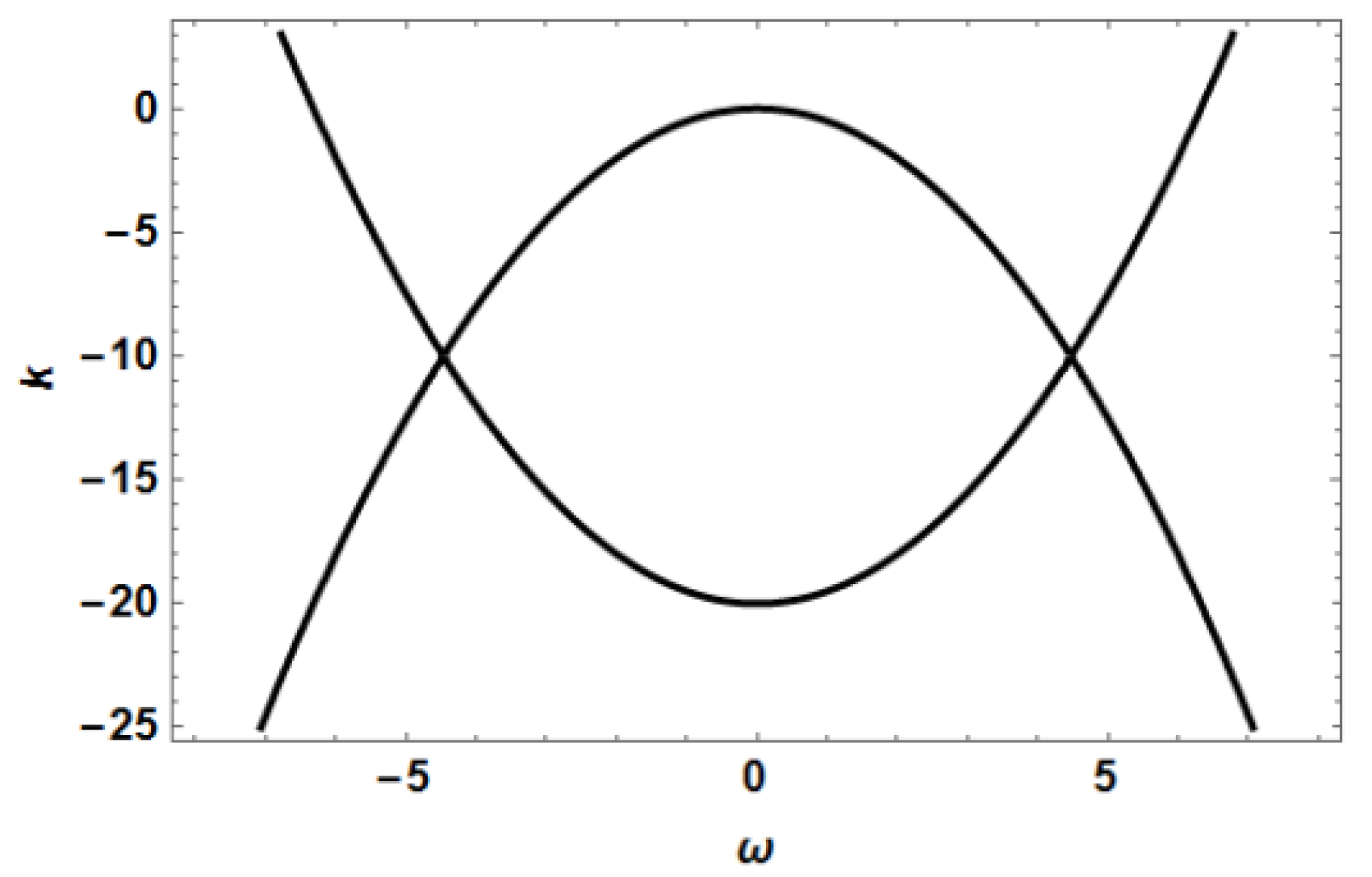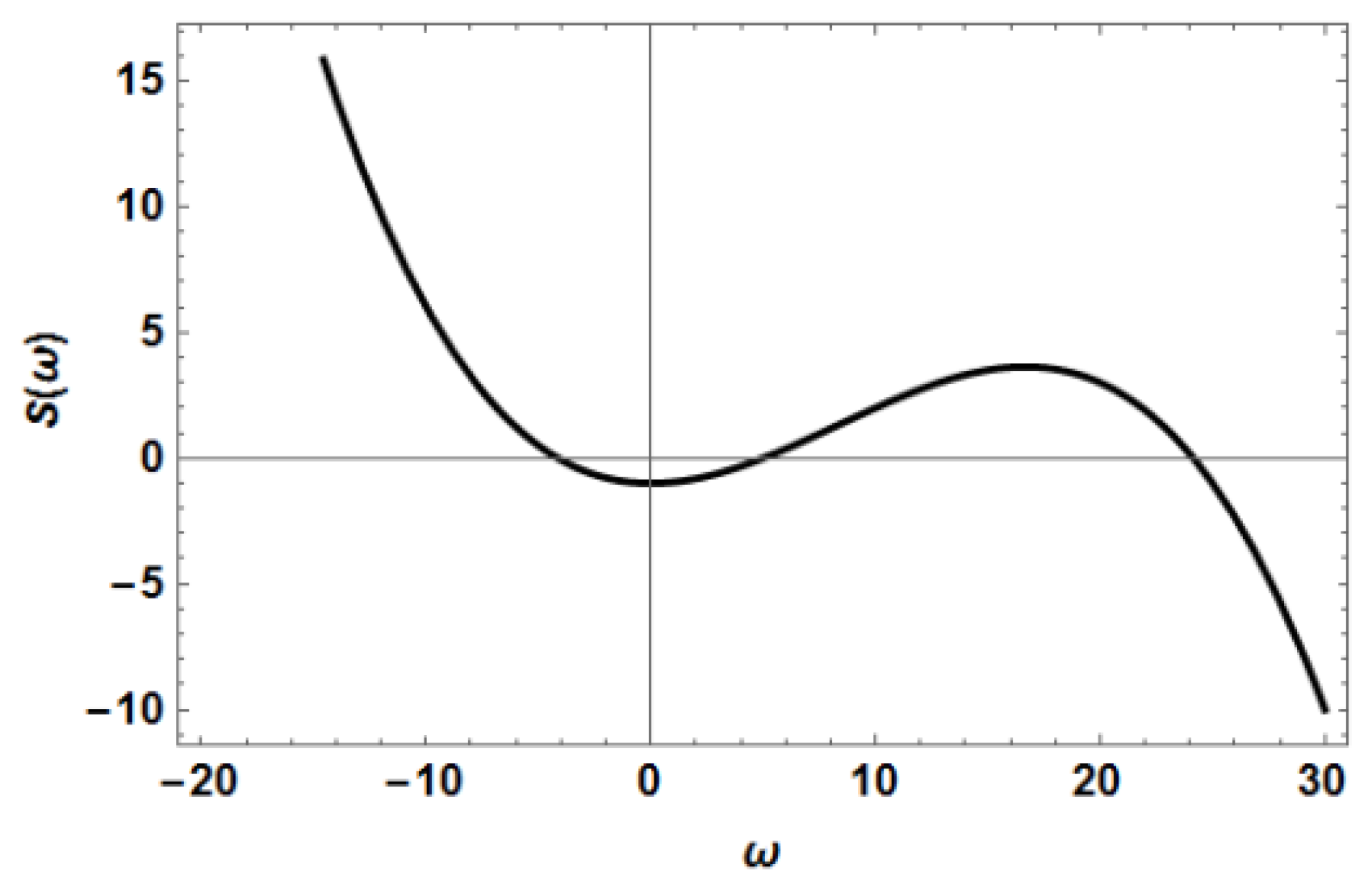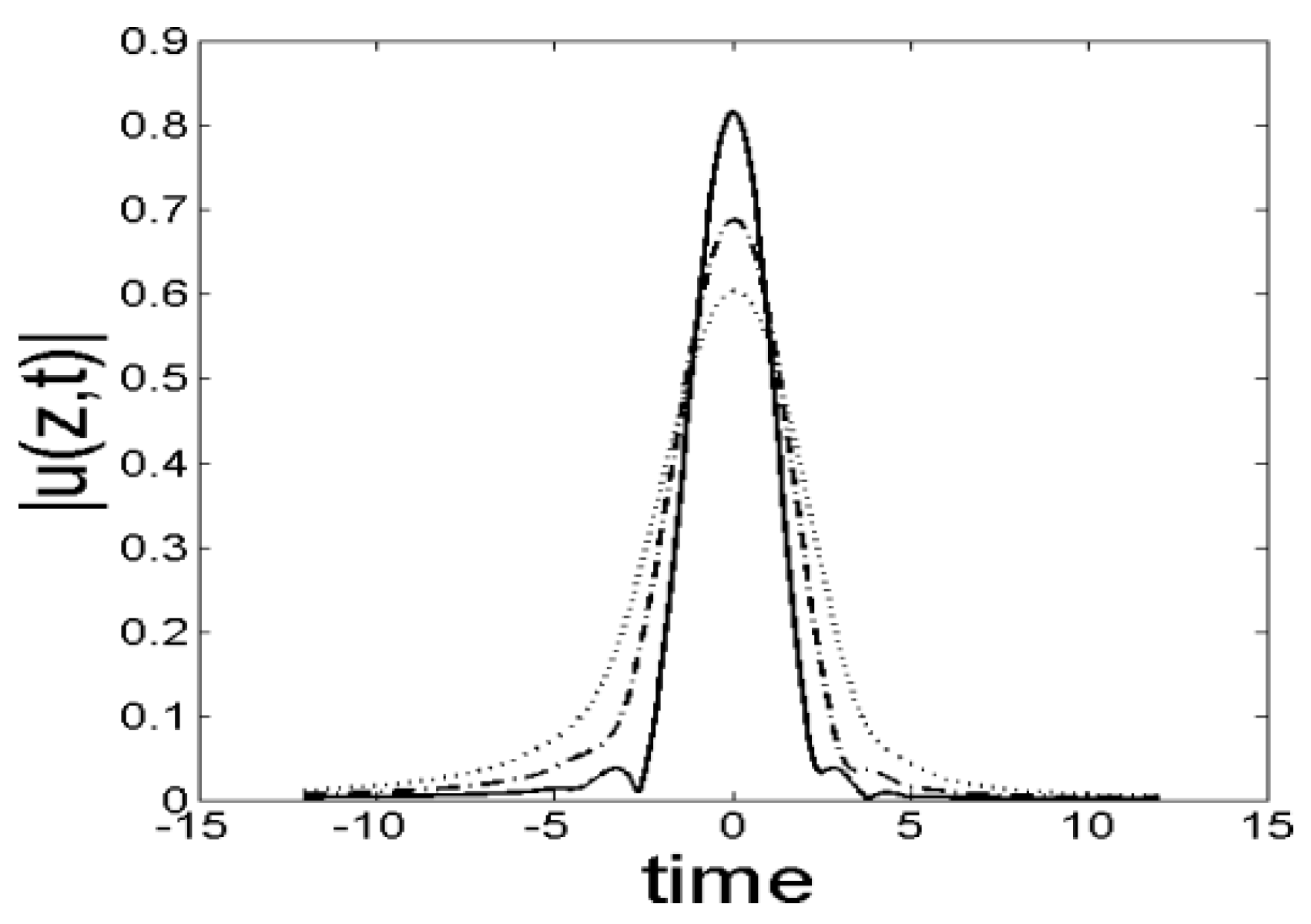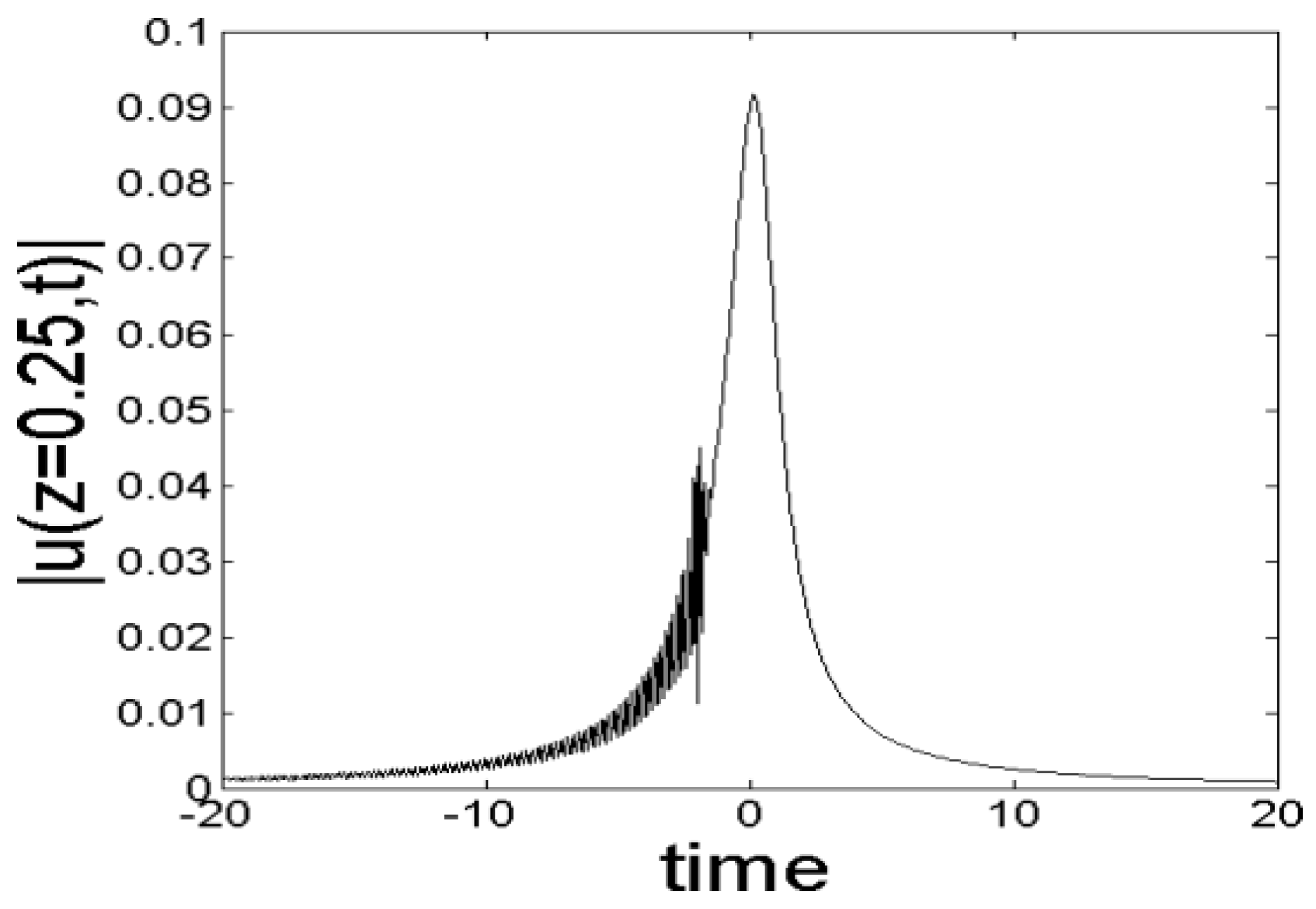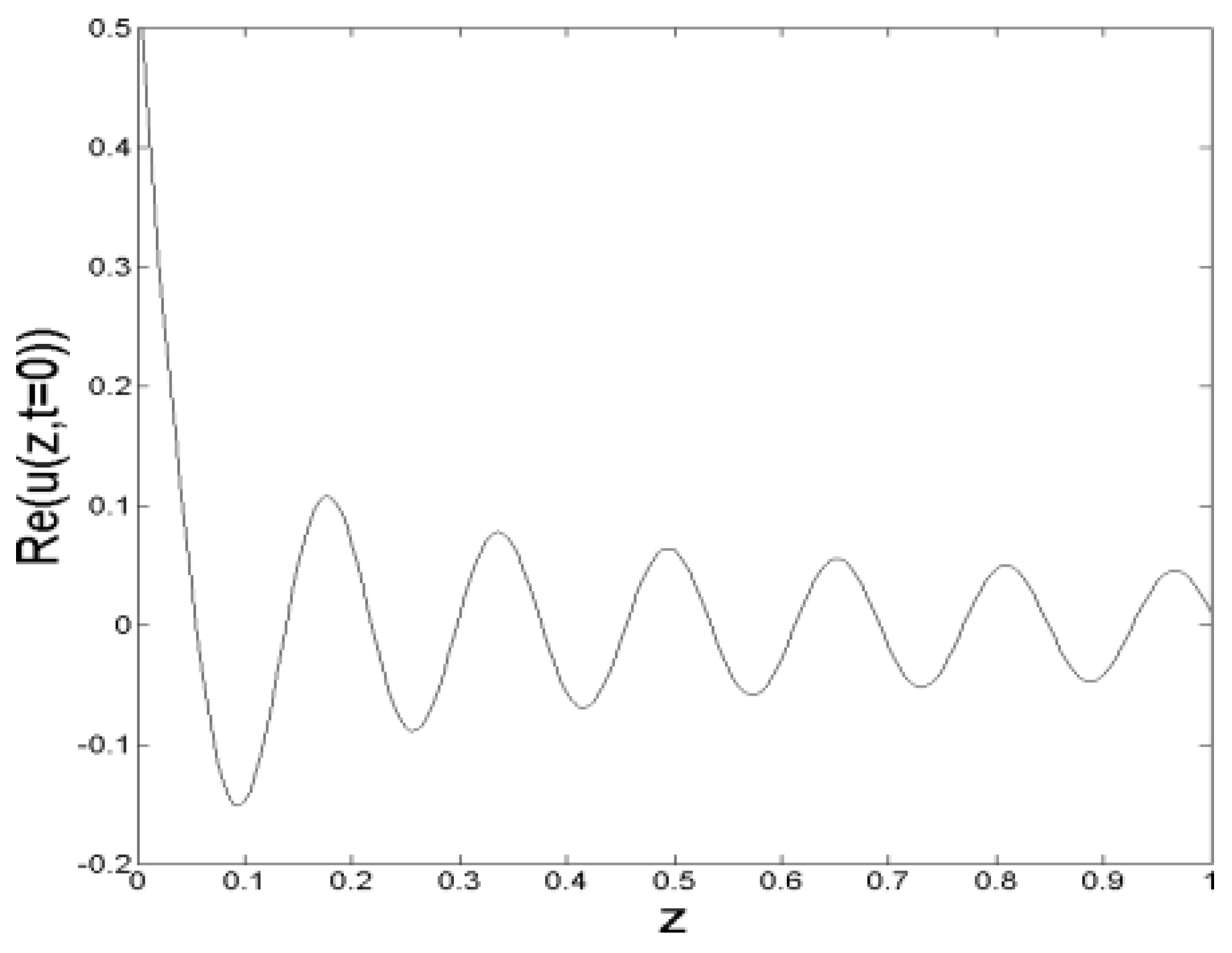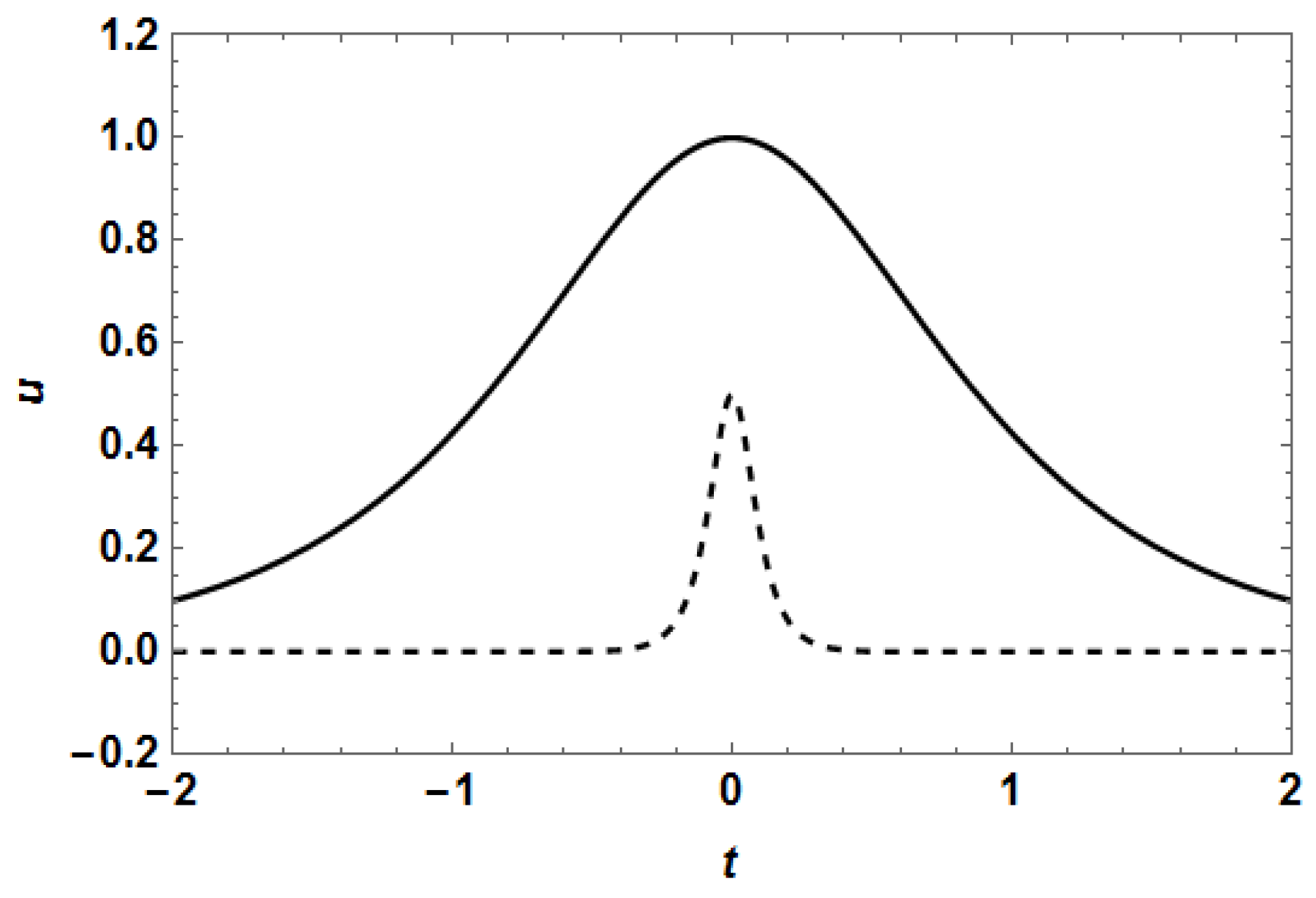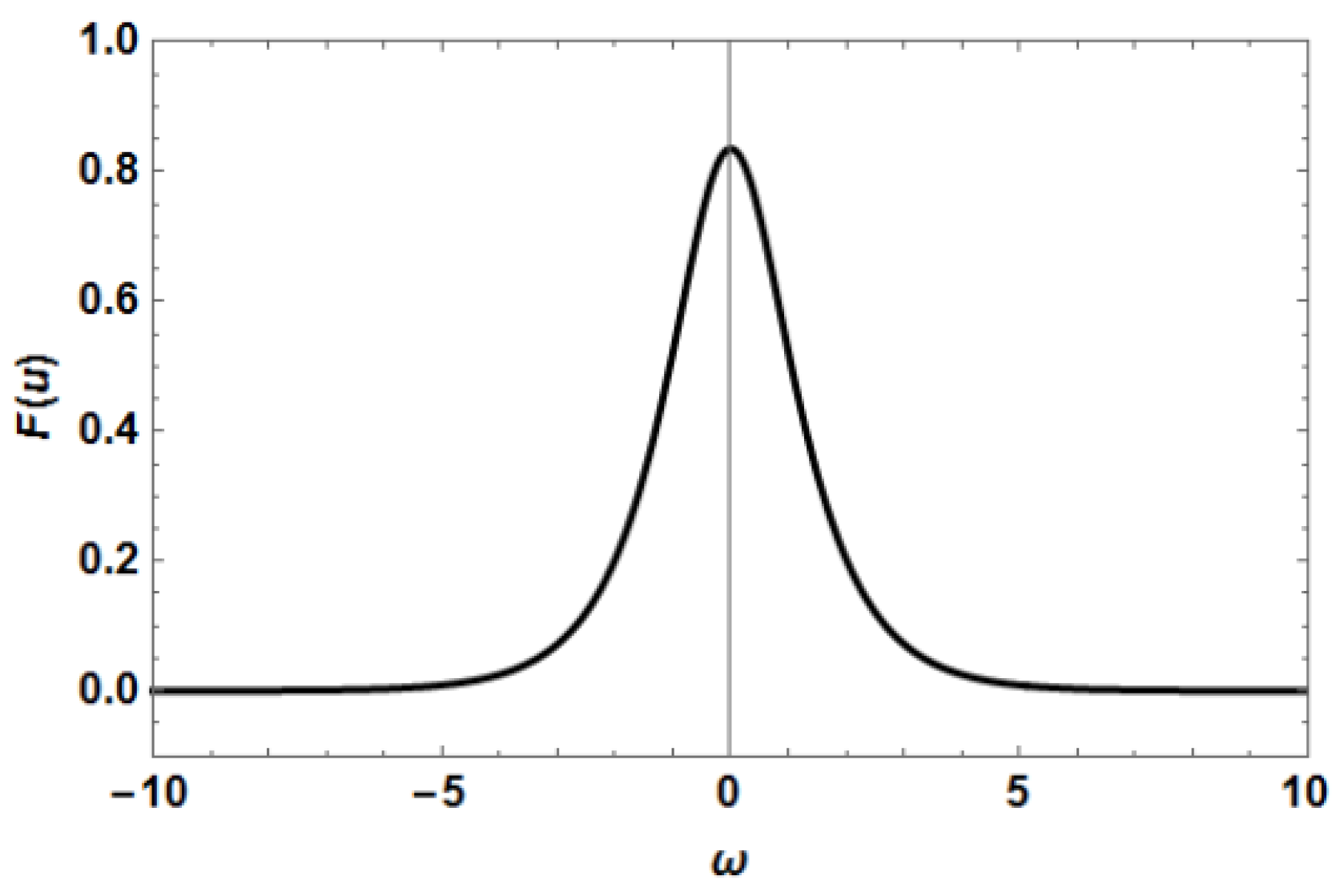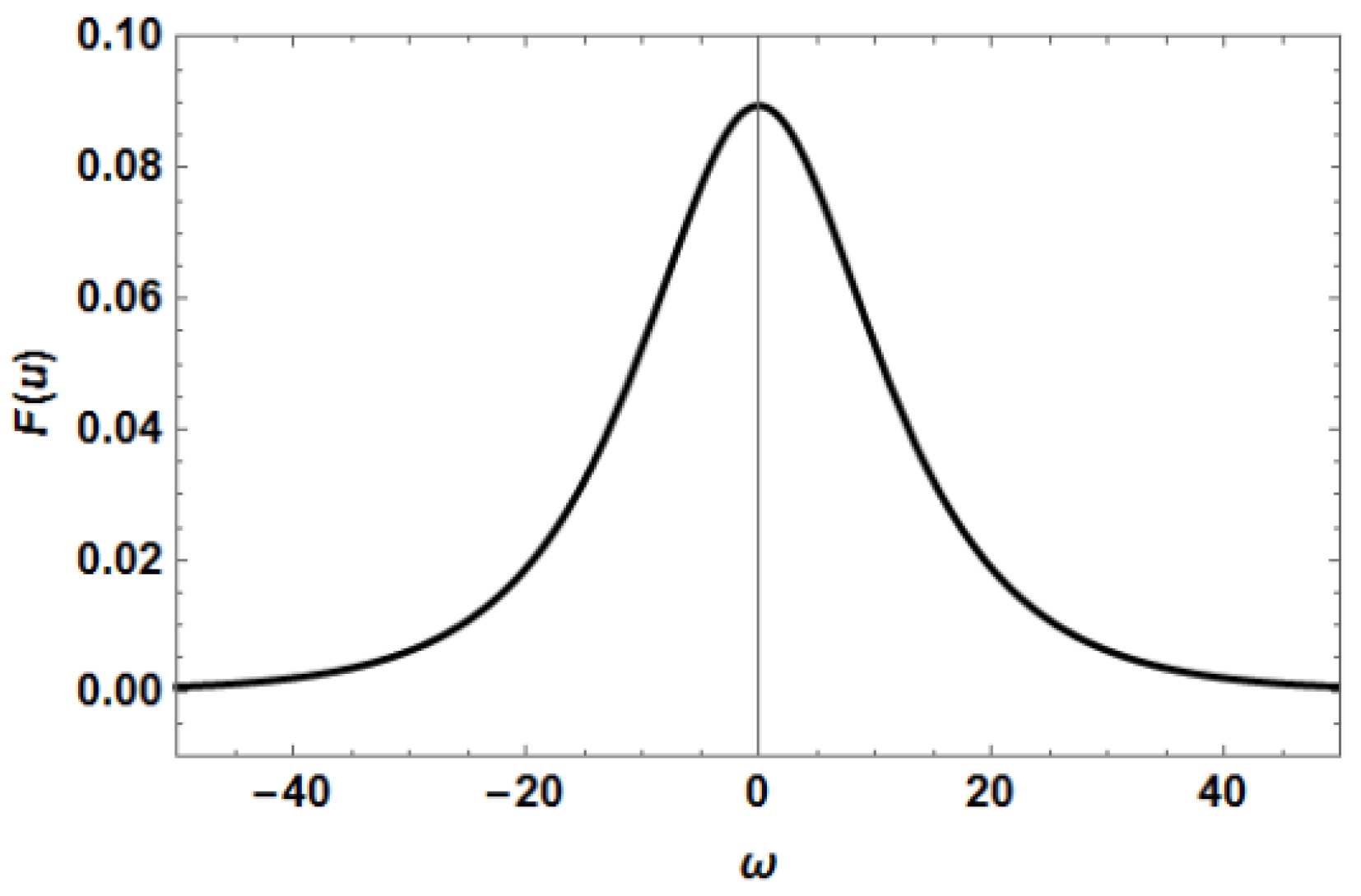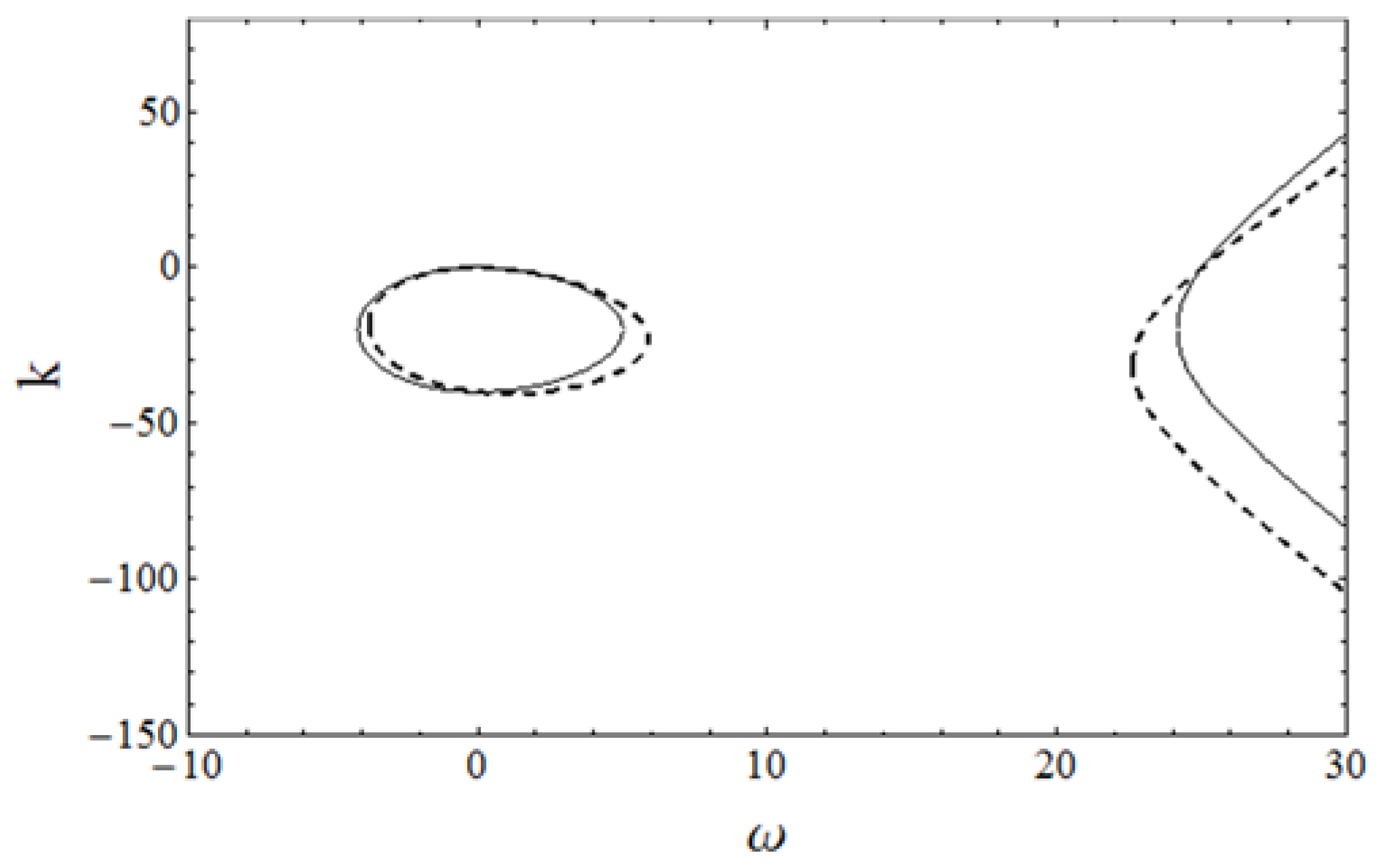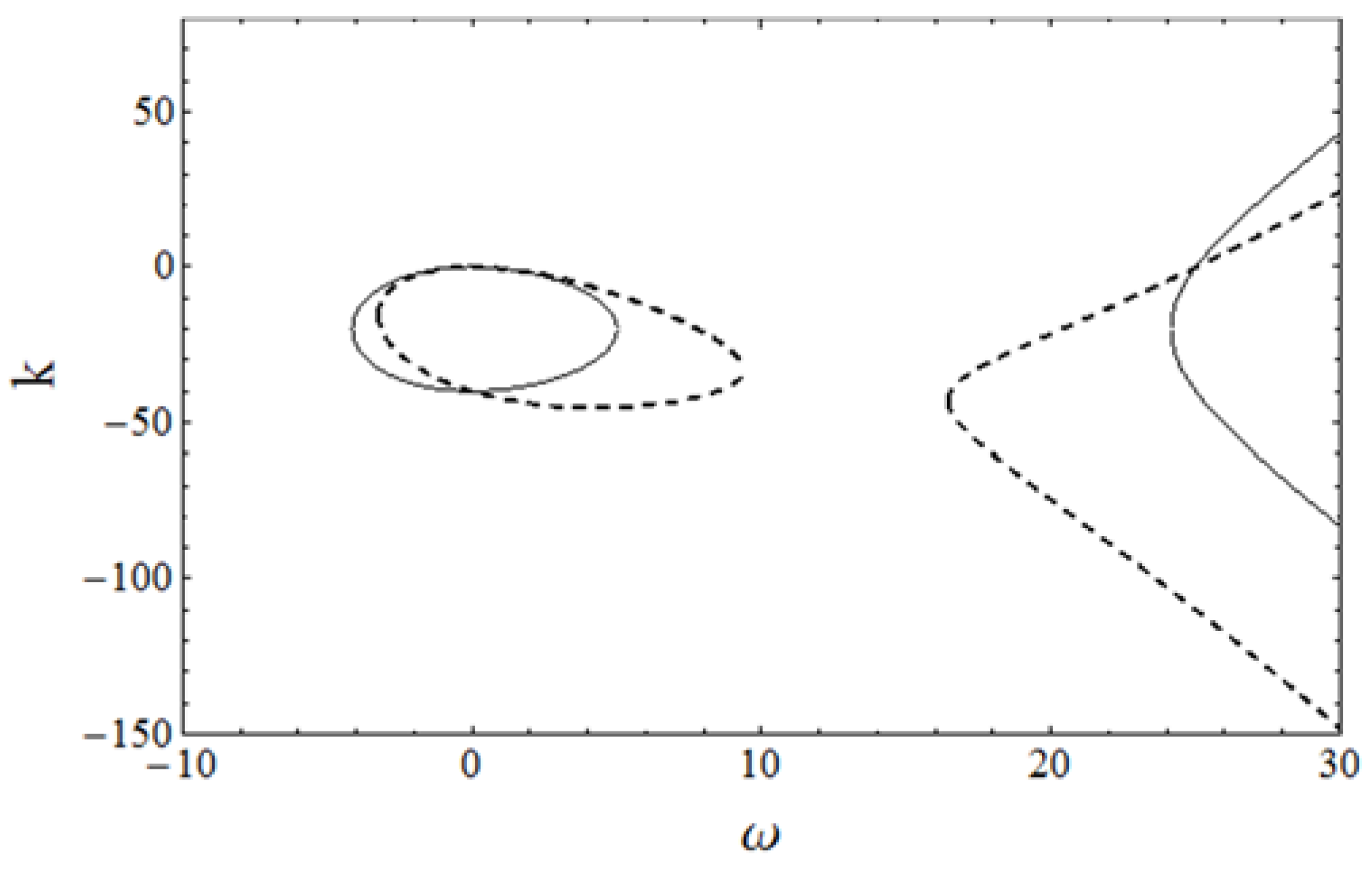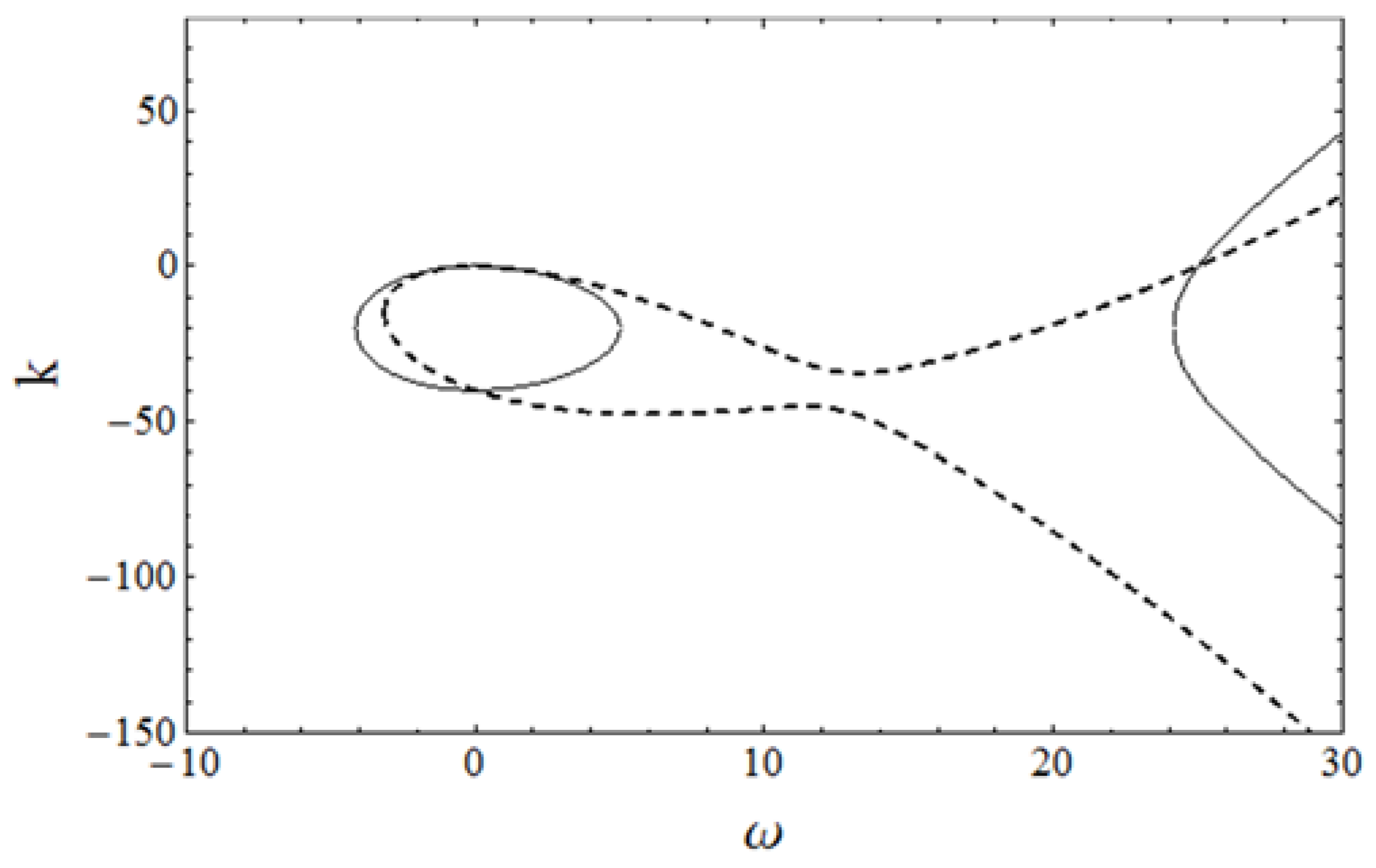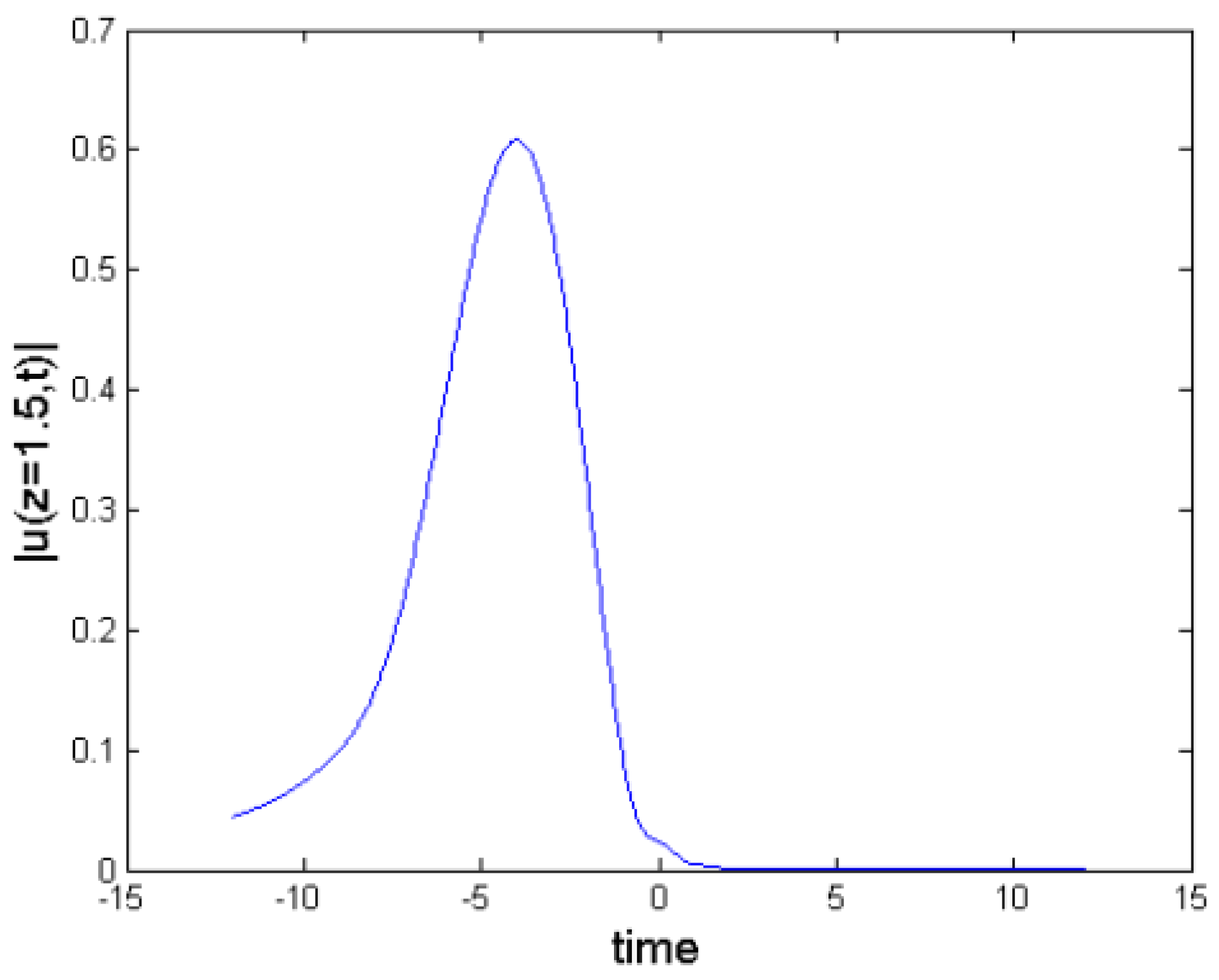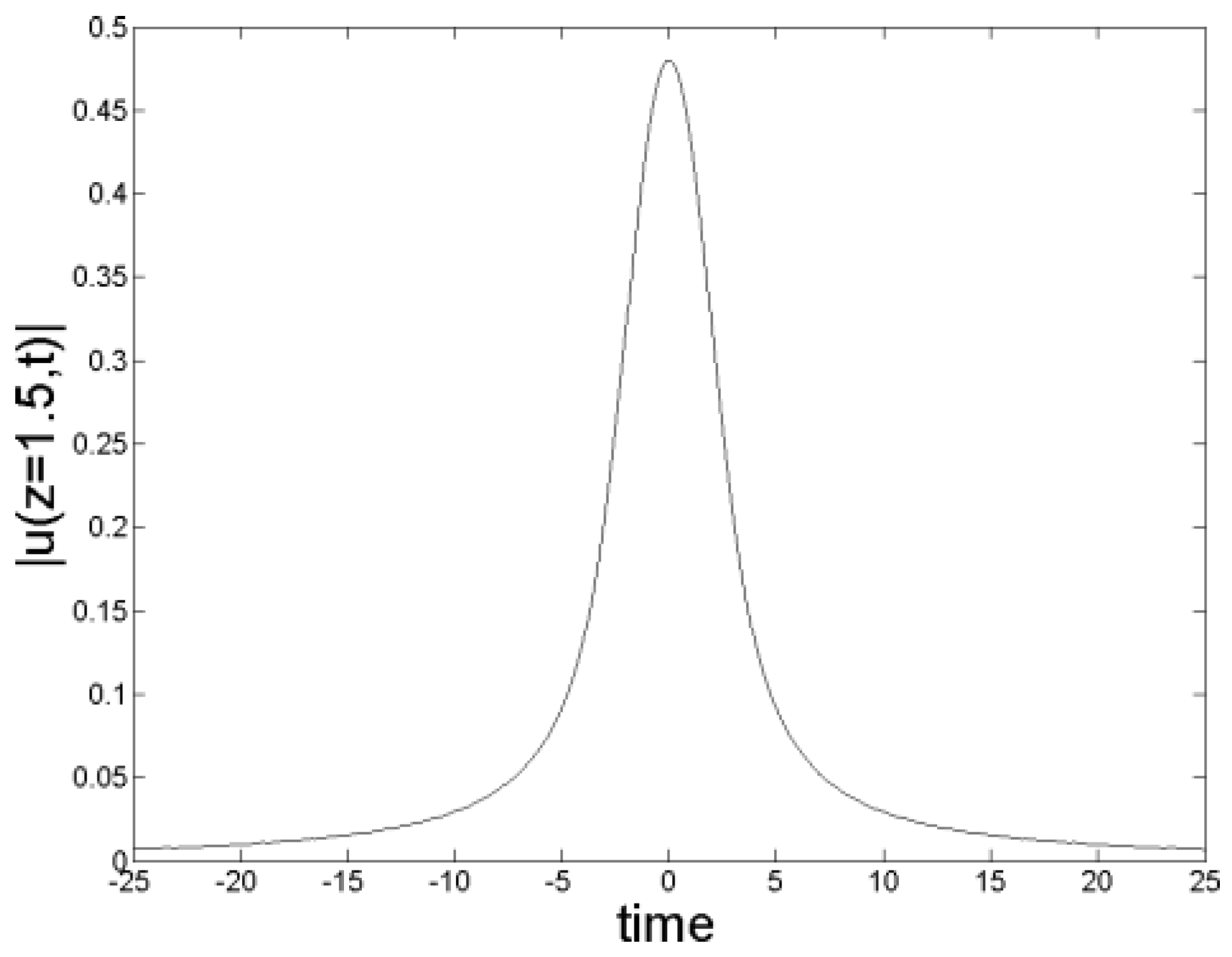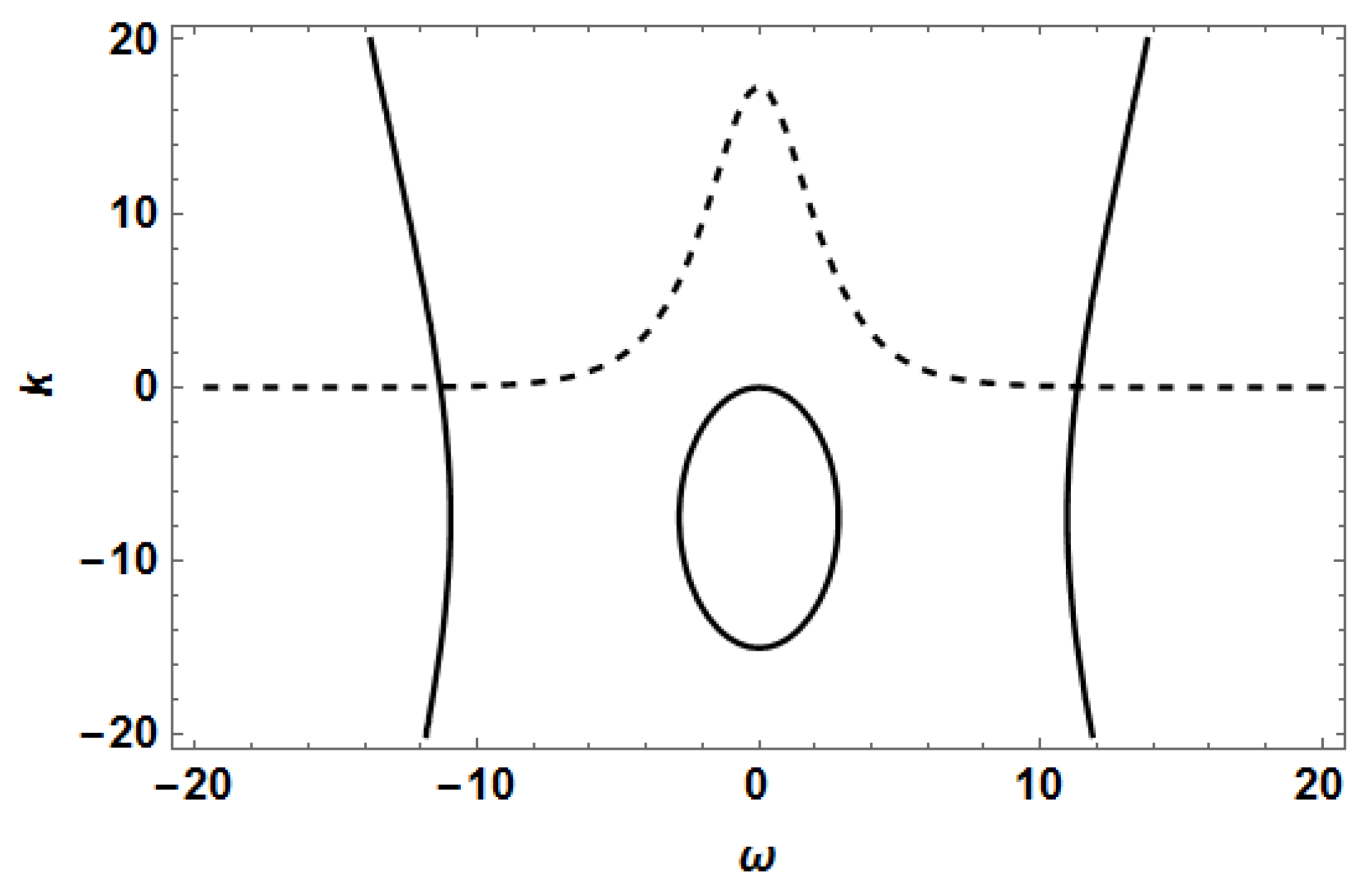3.1. The Issue of the Initial Conditions
In the study of optical solitons many variants of the nonlinear Shrödinger (NLS) equation have been considered in the past in order to describe the propagation of light pulses in optical fibers under different conditions. However, different as they are, most of these variants share a common denominator: they are first-order equations with respect to the evolution variable z. This characteristic implies that in all these cases the initial condition is sufficient to determine particular solutions of the corresponding equations. This fact seems to be consistent with physical reality: if we have an optical fiber (with well-defined characteristics: shape, composition, refraction index, type of cladding, etc.), and a laser beam (of known frequency) is sent into the fiber, the light intensity (as a function of time) at the beginning of the fiber (i.e., at ) is all we need to determine completely the behavior of light along the fiber.
On the other hand, the situation with Equations (4)–(8) is completely different. These equations are of second order in z, and this characteristic has two important consequences:
CONSEQUENCE 1:
With these equations we require two initial conditions, and , in order to determine a particular solution. This requirement is somewhat perplexing since physical intuition suggests that should be enough to determine the evolution of light along the fiber. Therefore, it seems as if we were in the presence of a contradiction: while mathematics indicates that Equations (4)–(8) require two initial conditions to define a particular solution, physics suggests that the knowledge of should be enough to define completely the behavior of the system.
CONSEQUENCE 2:
Although formal proofs are still lacking, several arguments suggest that the Cauchy problems for Equations (4)–(8) might be ill-posed (in certain regions of the space of coefficients ). The following results permit us to understand why this ill-posedness is to be expected:
- (i)
The presence of the non-paraxial term
in the equation:
makes the Cauchy problem for this equation ill-posed [
21,
41].
- (ii)
The presence of higher-order nonlinearities in equations of the form:
makes their Cauchy problems ill-posed if
and
[
42].
- (iii)
The presence of higher-order derivative
in the equation:
makes the Cauchy problem for this equation linearly ill-posed [
43].
- (iv)
The solutions of the linear Equations (4) and (5) and the linear parts of Equations (6)–(8) contain decaying as well as growing modes of the form
, as we shall see in
Section 3.2 and
Section 3.3. The existence of these modes makes the corresponding Cauchy problems linearly ill-posed [
43].
- (v)
Attemps of solving initial value problems for Equations (4)–(8) by finite differences in t, and Runge-Kutta algorithms in z, encounter difficulties that are typical of ill-posed problems.
At first sight these two consequences seem to be unrelated. However, as we explain in the following, there is a connection between them. Let us begin by paying attention to Consequence 2. If the Cauchy problems associated to Equations (4)–(8) are indeed ill-posed, then (as Hadamard first observed [
44]) it would be necessary to impose certain compatibility conditions among the initial conditions, for these problems to have global solutions (i.e., solutions defined for all
t). Consequently, these compatibility conditions will establish a link between the two initial conditions
and
, thus implying that, essentially, the initial condition
does indeed determine the future of the system, as physical intuition suggested. In this form, the compatibility conditions required by the ill-posedness of these problems (i.e., by Consequence 2), solve the apparent contradiction contained in Consequence 1 (i.e., the contrast between the mathematical requirement of two initial conditions, and the physical suggestion that only one condition should be necessary).
In the following two sub-sections we will examine different solutions of Equations (4) and (5), corresponding to different initial conditions . We will see that the behavior of these solutions is particularly interesting if the initial condition is a narrow solitary wave.
3.2. Solutions of Equation (4)
Let us obtain the solution of Equation (4) corresponding to a given initial condition . We will see that we do not have to specify the value of .
Let us begin by calculating the Fourier transform (FT) of Equation (4) (with respect to
t):
In this equation we have defined:
The solution of Equation (28) can be obtained immediately:
where
and
are the following functions of
:
where the
plus sign in front of the radical corresponds to
, the
minus sign corresponds to
, and the radicand
is given by:
From Equation (30) it follows that:
and from Equations (30) and (33) we can obtain the system:
and this system gives us the values of the coefficients
and
in terms of the functions
and
:
Now we can observe something interesting. Let us consider, for example, the particular case when
,
and
. In this case the radicand
(given in (32)) has the form shown in
Figure 6.
We can see in this figure that
if
or
, and
if
or
, where the frequencies
are the values shown in (14). Taking into account the signs of
, we can write
and
in the following way:
We can see that
has a positive real part when
and
, and therefore for frequencies within these two intervals the first term on the right-hand-side (rhs) of Equation (30) grows exponentially in
z. As this growth is completely unphysical (as it would imply a fictitious energy growth), the coefficient
has to be equal to zero, and consequently from Equation (36) it follows that there is an unexpected relationship between
and
:
thus implying that:
Therefore, as far as Equation (4) is concerned, the perplexing situation associated to the Consequence 1 (mentioned in the previous sub-section) is completely clarified: physically realistic solutions of Equation (4) are indeed completely determined by the initial condition , as physics suggested. Once is chosen, the function is determined by Equation (41).
Now let us calculate the solution of Equation (4) corresponding to a soliton-like initial condition of the form:
If we take the coefficients
,
and
in Equation (4), and the parameters
and
in Equation (42), the evolution of the pulse can be seen in
Figure 7, which shows the form of
for
, 1.0 and 1.5. We do not see anything special in this figure, which is somewhat disappointing, since we expected an unusual behavior due to the awkward form of the dispersion relation
shown in
Figure 2.
If we now obtain the solution of Equation (4) (with the same coefficients indicated above) and using again an initial condition of the form (42), but with
and
, the result is more interesting. In this case small ripples are generated on the leading edge of the pulse (i.e., the left hand side of the pulse), as shown in
Figure 8.
As the pulse advances along the fiber these ripples form a well-defined radiation wavetrain which propagates to the left of the pulse, as shown in
Figure 9 and
Figure 10.
At first sight, the radiation seen in
Figure 9 might seem similar to the small-amplitude radiation waves emitted by solitary pulses which obey equations such as the following [
1,
2,
11]:
However,
Figure 9 and
Figure 10 show that the radiation emitted by the solution of Equation (4) possesses a unique characteristic, that no other model of optical pulses has ever predicted:
the emission of radiation stops abruptly at a certain point along the retarded-time axis, and this point moves away from the pulse’s peak at a constant velocity. To understand clearly what this means we should remember that the independent variable “
t” which appears in Equations (1), (4)–(8) and (26), and appears at the horizontal axes in
Figure 8,
Figure 9 and
Figure 10, is not the laboratory time, but the so-called
retarded time. Therefore, the graphs shown in
Figure 8,
Figure 9 and
Figure 10 display the time-dependence of the square of the light intensity as measured by observers placed at different points (i.e., different values of
z) along the optical fiber, but each of these observers has shifted his/her time origin in such a way that the time
corresponds to the instant when the pulse’s maximum passes through the point
z. Consequently, a graph such as the one shown in
Figure 10 tells us that the radiation arrives at the observer placed at the position
z before the arrival of the pulse. This implies that the radiation advances
faster than the pulse. Moreover, it should be noticed that the point where we see an abrupt interruption of the radiation wave
corresponds to the endpoint of the radiation wavetrain, since the first radiation waves that were emitted have already moved far away towards the left of the graph.
If we obtain numerical results similar to those shown in
Figure 9 and
Figure 10, but for
and
, we can see that if the observer advances a distance
along the optical fiber, the endpoint of the radiation wavetrain recedes to the left of the retarded time axis approximately
, thus implying that this endpoint moves along the time axis with an “inverse velocity”
. It might be worth emphasizing that in the study of light pulses along optical fibers
the evolution variable is not the time, but the distance along the fiber, and therefore the “inverse velocity”
is more adequate to describe the movement of radiation fronts (or pulses) such as those shown in
Figure 9 and
Figure 10, when they travel along the retarded time axis.
To understand why the end point of the radiation wave moves to the left of the retarded time axis with an inverse velocity
we must remember that the radiation emitted by optical pulses is usually the result of a resonance between these pulses and the small-amplitude radiation waves capable of traveling along the fiber. This resonance occurs when an optical pulse has a wavenumber
that is contained in the range of wavenumbers permitted by the dispersion relation
of the system. In the case of Equation (4) we know that the dispersion relation is given by Equation (12), and the form of
is shown in
Figure 2 for the coefficients
,
and
. What we do not know is the wavenumber corresponding to the solution of Equation (4) whose profiles are shown in
Figure 8,
Figure 9 and
Figure 10. However, we can determine this wavenumber from the graphs of the real and imaginary parts of
shown in
Figure 11 and
Figure 12.
From these figures it follows that
, and therefore a horizontal line placed at
intersects the dispersion relation
shown in
Figure 2 at two points:
and
. The first of these points does not correspond to a traveling wave (as its frequency is zero), but the second one corresponds to a linear wave with a resonant frequency
, phase velocity
and group velocity
(i.e., in fact we are talking of
inverse velocities,
, as mentioned in the previous paragraph). We can see, therefore, that the endpoint of the radiation wavetrain that we see in
Figure 9 and
Figure 10 moves to the left of the retarded time axis at the group velocity corresponding to the resonant frequency
.
It should be noticed that the value
, which we obtained from
Figure 11 and
Figure 12, could also be obtained from Equations (31) and (32). If we define
, we can approximate
, and therefore Equation (31) implies that
. Consequently, when
, Equation (30) takes the form
, and from this equation it follows that
will contain the factor
, thus implying that
has a wavenumber
. As we used
to obtain
Figure 11 and
Figure 12, the origin of the value
is now clear.
We now understand the origin of the velocity of the endpoint of the radiation wavetrain shown in
Figure 9 and
Figure 10. However, we still do not know why this endpoint exists. In other words, we still do not know why the pulse stops emitting resonant radiation at a certain instant.
The clue to understand why the emission of radiation ends abruptly lies in the contrast between
Figure 7 and
Figure 10.
Figure 7 shows no radiation at all, while in
Figure 10 the radiation is quite conspicuous. The reason for this difference must be necessarily in the initial conditions used to obtain the solutions of Equation (4) which led to these two figures. These initial conditions are shown in
Figure 13, and the absolute values of their Fourier transforms are shown in
Figure 14 and
Figure 15. We can see that the initial condition which lead to
Figure 10 is much narrower than the initial condition corresponding to
Figure 7, but the graphs which really suggest the answer to the presence of radiation in
Figure 10, and its absence in
Figure 7, are the Fourier transforms (FT) shown in
Figure 14 and
Figure 15.
The FT shown in
Figure 14 shows that the spectrum corresponding to the initial condition which lead to
Figure 7 is essentially contained in the interval
, and it is practically zero for
, which is the second interval where the dispersion relation
is well defined (remember, from
Figure 2, that
is defined in two intervals:
and
) Therefore, it is impossible for the initial condition which lead to
Figure 7 to resonate with the linear waves with frequencies
, since this initial condition has no frequency components in this interval. On the contrary, the spectrum shown in
Figure 15 shows that the initial condition which leads to
Figure 10 contains significant frequency components with
. Consequently, when this initial pulse starts traveling along the fiber, it resonates with the linear wave with wavenumber
(the pulse’s wavenumber) and resonant frequency
, and thus the emission of radiation begins. However, the pulse’s width will begin to grow (and its spectrum will become narrower) as a result of the dispersive terms
and
which appear in Equation (4). As the dispersion of the pulse will continue indefinitely (since Equation (4) does not contain any nonlinear term which could cancel this dispersion), a moment will necessarily arrive when the pulse will be too wide, and its spectrum will be too narrow to have frequency components with
. Moreover, the components of the pulse with frequencies in the interval
will die quickly, since the dispersion relation (shown in
Figure 2) does not permit the propagation of linear waves with these frequencies. Therefore, a moment will arrive when the pulse´s spectrum will be essentially contained in the interval
(where the dispersion relation allows the propagation of linear waves), and then the pulse will no longer be able to resonate with the wave with
(the resonant frequency), and the emission of radiation will stop. So, the interruption of the radiation is due to the fact that the pulse’s spectrum is confined to live in the interval
(far from the resonant frequency
), and the presence of the forbidden frequency gap
seen in
Figure 2 strongly contributes to this confinement.
We have thus seen that a very original consequence of having a dispersion relation given by an elliptic curve such as that shown on
Figure 2 is the abrupt interruption of the resonant radiation emitted by a narrow pulse which obeys the linear Equation (4). Therefore, this novel radiation process is the consequence of the
simultaneous presence of the non-slowly-varying-envelope term
and the third-order temporal derivative.
To close this sub-section it is worth observing that no qualitative changes are to be expected if we introduced the mixed derivative
in Equation (4). The equation thus obtained could be solved by Fourier transforms, just as we solved Equation (4). The form of the Equation (30) would still be valid, although the form of the functions
and
would be slightly different. In this case (when we take into account a term of the form
in Equation (4)), instead of Equations (31) and (32) we would have:
It should be emphasized that the key ingredient which produces the peculiar radiation process shown in
Figure 9 and
Figure 10 is the presence of gaps of forbidden frequencies in the dispersion relation of Equation (4). It is interesting to investigate if these gaps survive if we introduce a term of the form
in Equation (4). Therefore, let us consider the equation:
and let us take the same coefficients
,
and
used to obtain
Figure 7,
Figure 8,
Figure 9,
Figure 10,
Figure 11 and
Figure 12. Concerning the coefficient
, one of the reviewers that revised this paper observed that in typical fibers
and the absolute value of the ratio
is approximately equal to the dimensionless number
, where
Z and
T are characteristic values of length and time, respectively, and
is the reciprocal group velocity. In
Figure 16,
Figure 17,
Figure 18 and
Figure 19 the dashed curves show the form of the dispersion relation of Equation (47) for three different values of
(
,
and
), and the continuous curve shows the dispersion relation when the term
is absent.
We can see that the finite gap of forbidden positive frequencies survives in
Figure 16 and
Figure 17, but it disappears in
Figure 18. Therefore, the presence of the term
in Equation (47) modifies the gaps of forbidden frequencies in a significant way. In fact, the gap of forbidden positive frequencies will disappear if the coefficients
,
,
and
are such that the equation
has only one real root (
being the polynomial shown in Equation (46)). In particular, for pulses propagating in a typical optical fiber with a group velocity
(
being the light speed in vacuum) the band of forbidden frequencies may not exist for processes whose characteristic dimensions are
and
, as for these values
, and
Figure 16,
Figure 17 and
Figure 18 show that the band of forbidden frequencies does not exist if
(and
,
and
have the values used to obtain
Figure 16,
Figure 17 and
Figure 18). However, the value of
might be smaller in special fibers where
is closer to
(as in photonic fibers with air holes), and we consider processes where
is also closer to
. In such conditions the band of forbidden frequencies might exist. In fact, the generation of a band of forbidden frequencies has already been observed by Fang et al. [
38] during the propagation of very short optical pulses in photonic crystal fibers, a result that Fang et al. considered “the most distinctive feature” of this process.
It might be interesting to see how pulses evolve when the width of the band of forbidden frequencies shrinks, as in the dispersion relation shown by the dashed curve in
Figure 17. In
Figure 19 we can see the modulus of the solution (at
) of Equation (47) corresponding to a narrow initial pulse of the form (42), with
and
, and the coefficients used to obtain the dashed curve in
Figure 17.
We can see that the graph shown in
Figure 19 is similar to that shown in
Figure 10, but the amplitude of the radiation is significantly higher. However, the radiation also stops at a definite time (as in
Figure 10), due to the presence of the band of forbidden frequencies shown in
Figure 17.
If we now calculate the solution of Equation (47) corresponding to the broader initial condition used to obtain
Figure 7, and the same coefficients used in
Figure 19, we obtain
Figure 20. This figure shows that the pulse does not emit any radiation at all, as expected, since the initial condition is now a broad pulse, and its Fourier transform is too narrow to have frequency components which may resonate with the small-amplitude linear waves corresponding to the right branch of the dispersion relation seen in
Figure 17.
Figure 20 also shows that the position of the pulse has been shifted to the left, a result that is due to the presence of the term
in Equation (47), and the negative value of the coefficient
(
Figure 7 shows that the pulse does not move to the left when the term
is absent).
3.3. Solutions of Equation (5)
Now let us investigate how the solutions of Equation (5) behave. As we saw in
Figure 4, when the coefficients
,
and
satisfy the condition (17), the dispersion relation presents two finite bands of forbidden frequencies (defined in (22)). Therefore, we expect that narrow solitons will exhibit a behavior similar to that of the solutions of the Equation (4). More precisely, we expect that if take an initial condition whose Fourier transform (FT) is wide enough to contain significant frequency components in the intervals
and
, the pulse will start radiating, but the radiation will stop at some time, when the pulse widens and its FT becomes too narrow. To verify this expectation we obtained the numerical solution of Equation (5) with coefficients
,
and
, and using an initial condition
of the form (42) with
and
. As in the case of Equation (4), we can obtain the solution of Equation (5) by calculating the Fourier transform (FT) of this equation, and the FT of the solution also has the form shown in Equation (30), with
given by Equation (31), but with the function
which appears within the square root now defined as follows:
As this function is positive on two regions of the
axis, the function
(given in Equation (30)) would grow exponentially in
z, unless we impose the restriction
. This restriction implies that Equation (41) is also valid in this case (but using Equation (48) in the expression (31) which defines the function
). Therefore, to solve Equation (5) we used
as defined in Equation (42), and we calculated
with Equation (41). In
Figure 21 we can see the profile of
corresponding to the initial condition (42) with
and
. As expected, we see that the pulse starts emitting radiation, but afterwards the radiation stops. The only important difference in comparison with the behavior of the solutions of Equation (4) is that the solution of Equation (5) emits radiation in both directions, due to the fact that its dispersion relation, shown in
Figure 4, is now symmetrical with respect to the wavenumber axis.
On the other hand, in
Figure 22 we can see the profile of another solution of Equation (5) corresponding to an initial condition of the form (42), but now using
and
(and the same coefficients
,
and
). In this case no radiation is observed because the initial pulse was very wide, and its FT was very narrow, and therefore the initial FT has no significant frequency components in the intervals
and
(where the resonant frequencies are located).
We have thus seen that the behavior of the radiating pulses of Equations (4) and (5) is similar, except that the solutions of Equation (5) emit radiation in both directions, and those of Equation (4) only radiate to the left. However, Equations (4) and (5) differ in a significant aspect. In the case of Equation (4) the function defined by Equation (32) is always positive in a portion of the real axis, and consequently is always necessary to impose the restriction which leads to the relationship between and given by Equation (41). On the other hand, in the case of Equation (5), depending on the values of the coefficients , and , the function defined by Equation (48) may be positive over certain frequency intervals, and in these cases the restriction is necessary, and the Equation (41) again defines a necessary relation between and . However, for certain coefficients, the function might be always negative, and then the values of the functions would be imaginary for all frequencies. In these cases there is no reason to impose the restriction , and with the disappearance of this restriction also the relations (40) and (41) disappear. Therefore, in the case of Equation (5), when and are both imaginary, we face again the question: how do we specify the initial condition ? In the following paragraph we address this question.
When
the Equations (40) and (41) no longer hold, but we can obtain an approximate relation between
and
by considering what happens when we send a light pulse at the beginning of an optical fiber. As the pulse enters into the fiber, the wavelength of the carrier wave changes (since the light’s velocity is different inside the fiber), and this change introduces a factor
in the mathematical form of the pulse. In other words, at the beginning of the fiber (inside the fiber, near the point
) the form of the light pulse will be:
where
defines the temporal profile of the pulse. Consequently, from Equation (49) it follows that:
and this equation, whose FT is similar to Equation (40), implies that the form of the function
determines the form of
. It should be noticed, however, that we do not know the value of the parameter
. This parameter depends on the exact form of the refractive index of the fiber as a function of the light intensity. However, if we approximate the wavelength of the light inside the fiber in the form
, where
is the wavelength outside the fiber, and
is the intensity-independent part of the refractive index, then we can approximate
in the form:
Therefore, when there is no justification for using Equation (41) to calculate , this function might be calculated by means of the approximate Equations (50) and (51). In fact, in the following section we will see that the exact soliton solutions of Equation (6) are indeed consistent with a linear relationship between and , such as that given by Equation (50).
To close this section, it is important to emphasize that the peculiar radiation behavior observed in
Figure 9,
Figure 10,
Figure 19 and
Figure 21 is a direct consequence of the presence of
bands of forbidden frequencies in the dispersion relations of Equations (4), (5) and (47), and these forbidden bands are the result of the interplay between the non-SVEA tem
and higher-order dispersive terms such as
or
. Therefore, the principal lesson to be learnt from the study of Equations (4), (5) and (47) is the following: when a very short pulse is launched along an optical fiber, some of the frequencies which are contained in the initial pulse may not be permitted to travel along the fiber, since
bands of forbidden frequencies may appear in the dispersion relation of the equation which controls the propagation of the pulse. Although these forbidden bands may be cancelled by the influence of the term
(which we did not include in Equations (4) and (5)), a band of this type has already been observed in a photonic crystal fiber, as mentioned before [
38].





